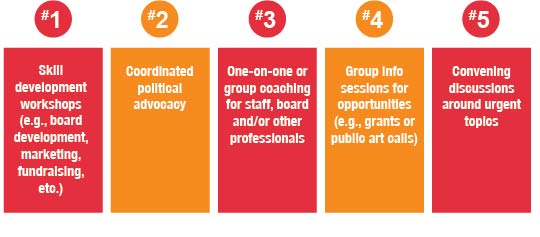Regional Arts & Culture Council 2022 Legislative Priorities
2022 State Legislative Priorities – Adapted from the Cultural Advocacy Coalition of Oregon
The Regional Arts & Culture Council’s (RACC) mission is to enrich our communities through arts and Culture. We envision a thriving region, powered by creativity, with arts and culture in every neighborhood. To do this, RACC promotes equity, diversity, inclusion and access and uses a racial equity lens to advocate for the equitable distribution of resources and the creation of public policies that will provide support for the arts ecosystem now and into the future.
This year, we are reminded that the history that we are looking to make is not for us, it is for the leaders who come after us. How we work together during our time here—both with our Team and our community, will determine how our region responds to crises in the future.
The opportunity to continue supporting our creatives and artists is paramount. RACC is leaning deeply into this space to ensure that they are supported and held during this unprecedented moment in history. We are here to ensure that they are here today, and tomorrow, enriching their communities through art and culture.
2021 was a crucial legislative year for Oregon’s vital cultural sector. We urged our state policymakers to prioritize arts, culture, heritage, and the humanities in order to encourage creativity, contribute to Oregon’s economic recovery and rebuild community. As we look to this season’s short legislative session, we continue to urge policymakers to Invest in Oregon’s creative and cultural life, supporting Oregonians’ values, promoting whole person health, strengthening communities, and attracting and retaining workers in an innovative and yet thriving economy.
This is an historic year for arts and cultural funding across the nation. We are proud that Oregon is joining in these efforts to provide advocacy and relief, and to elevate our creative economy. Here are legislative initiatives that RACC supports and is keeping on eye on during this season. Let’s shape an arts and culture environment that serves for the common good of all.
– Carol Tatch (Chief of External Operations) and Della Rae (Chief of Internal Operations)
ADVANCE EQUITABLE ACCESS TO A WELL-ROUNDED ARTS EDUCATION FOR ALL
The Arts Education for All Act-HB 5581 – will support and encourage arts education and programming for our young children, K-12 students, and youth and adults impacted by the justice system.
RACC supports and will continue to monitor the Arts Education for All Act for funding impacts in the arts in our local school districts and incarcerated youth and adults. A one-page summary of the Arts Education for All Act can be found here. The text of the legislation can be found here. To endorse, click here.
PUT CREATIVE WORKERS TO WORK IN OUR COMMUNITIES ACROSS THE COUNTY TO RECOVER THROUGH CREATIVE JOBS.
Introduced on August 13th in the House of Representatives by U.S. Reps Teresa Leger Fernández (D-NM) and Jay Obernolte (R-CA), the Creative Economy Revitalization Act (CERA)-HR 5019, and endorsed by Oregon Congresswoman Bonamici, will help communities recover through creative jobs.
The Creative Economy Revitalization Act (CERA) is a $300 million dollar program that will mitigate creative worker displacement, stimulate local creative workforce growth, strengthen connections for local creative small businesses and networks, create a pipeline for new creative jobs, enrich communities, increase access to culture, and invest in creative workers and local economies harmed by COVID-19. To read more and endorse CERA, click here.
SETTING $50 MILLION ASIDE THROUGH GRANTS THAT WILL PROVIDE IMMEDIATE RELIEF TO OUR ARTS AND CULTURAL ORGANIZATIONS
Oregon HB 4040 – Effective July 1, would appropriate money to the Oregon Business Development Department to develop and implement a program to award grants to Oregon cultural organizations in response to the negative impact of COVID-19 pandemic on organizations’ earned revenue. The text of legislation can be found here.
RACC’S 2022 LEGISLATIVE PRIORITIES
|
Ensuring American Rescue Plan Act (ARPA) funding allocated in 2021 is distributed quickly to the arts and culture sector
- The Oregon legislature allocated $50M in APRA funding to be distributed:
- $5M for movie theaters (anticipated Jan. 2022)
- $30M for “live venues” (anticipated Feb./March 2022)
- $15M for live venue support (anticipated in March/April 2022)
- RACC will continue to monitor and support Cultural Advocacy Coalition of Oregon’s (CACO) work with Business Oregon and legislative leaders to support progress and distribution of funds through these programs.
Advocating for additional funding support to the sector
- According to data from Americans for the Arts, Oregon’s art sector has lost an estimated $66M, with over 70% of entities expecting a “severe financial impact.”
- RACC supports CACO request of an additional $50M in funds to support the long-term recovery of the sector, including recruitment of staff, reopening, additional costs to put on productions, etc.
THE ECONOMIC IMPACT OF CORONAVIRUS ON THE ARTS AND CULTURE SECTOR – OREGON
“Americans for the Arts surveyed arts organizations and agencies of all types, genres, sices, and tax statuses for nearly a year to capture the human and financial impact of the coronavirus on America’s art sector.”
- 905 organizations participated in the survey
- $66,029,425 in financial loss
- $21,00 was the median loss
- 13% are not confident of their survival
- 71% expect sever financial impact
- 369 organizations were included in the Financial Data (Outliers and nul responses were removed prior to reporting)
- The median loss was $22,000
|
Supporting the renewal of special assessments for historic preservation
- History can be found in our people, museums, art, and even our buildings. RACC supports local and state initiatives ensuring the access and interest for all Oregonians in preserving the humanities through a variety of programs.






